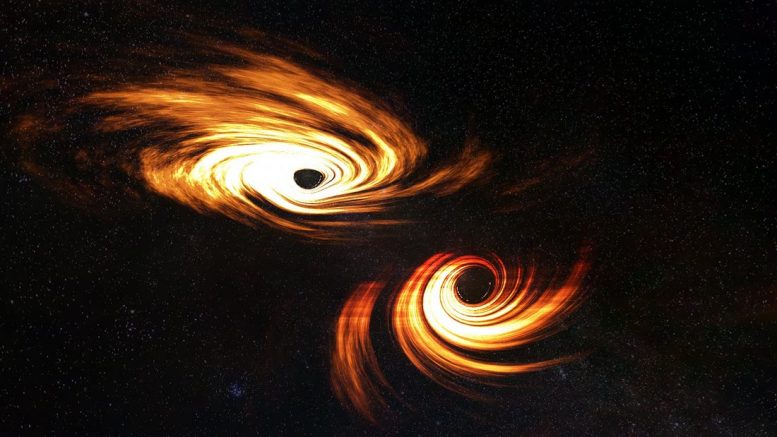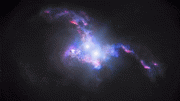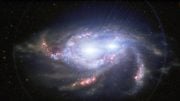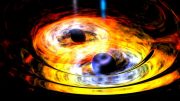A new study led by postdoctoral researcher Xingjiang Zhu from the ARC Centre of Excellence for Gravitational Wave Discovery (OzGrav), at Monash University, developed a new method to detect colliding supermassive black holes in our Universe.
At the center of every galaxy in our Universe lives a supermassive black hole—a black hole that’s millions to billions times the mass of our Sun. Big galaxies are assembled from smaller galaxies merging together, so collisions of supermassive black holes are expected to be common in the cosmos. But merging supermassive black holes remain elusive: no conclusive evidence of their existence has been found so far.
One way to look for these mergers is through their emission of gravitational waves—ripples in the fabric of space and time. A distant merging pair of supermassive black holes emit gravitational waves as they spiral in around each other. Since the black holes are so large, each wave takes many years to pass by us. Astronomers use a technique known as pulsar timing array to catch gravitational waves from supermassive binary black holes—so far to no avail.
In parallel, astronomers have been looking for the collision of supermassive black holes with light. A number of candidate sources have been identified by looking for regular fluctuations in the brightness of distant galaxies called “quasars.” Quasars are extremely bright, believed to be powered by the accumulation of gas clouds onto supermassive black holes. If the center of a quasar contains two black holes orbiting around each other (instead of a single black hole), the orbital motion might change the gas cloud accumulation and lead to periodic variation in its brightness. Hundreds of candidates have been identified through such searches, but astronomers are yet to find the smoking-gun signal.
“If we can find a pair of merging supermassive black holes, it will not only tell us how galaxies evolved, but also reveal the expected gravitational-wave signal strength for pulsar watchers,” says Zhu.
The OzGrav study seeks to settle the debate, determining if any of the identified quasars are likely to be powered by colliding black holes. The verdict? Probably not.
“We’ve developed a new method allowing us to search for a periodic signal and measure quasar noise properties at the same time,” says Zhu. “Therefore, it should produce a reliable estimate of the detected signal’s statistical significance.”
Applying this method to one of the most prominent candidate sources, called PG1302-102, the researchers found strong evidence for periodic variability; however, they argued that the signal is likely to be more complicated than current models.
“The commonly assumed model for quasar noise is wrong,” adds Zhu. “The data reveal additional features in the random fluctuations of gas accumulation onto supermassive black holes.”
“Our results are showing that quasars are complicated,” says collaborator and OzGrav Chief Investigator Eric Thrane. “We’ll need to improve our models if we are going to use them to identify supermassive binary black holes.”
Reference: “Toward the unambiguous identification of supermassive binary black holes through Bayesian inference” by Xing-Jiang Zhu and Eric Thrane, 23 April 2020, The Astrophysical Journal.
DOI: 10.3847/1538-4357/abac5a
arXiv: 2004.10944










did black hole have any mass